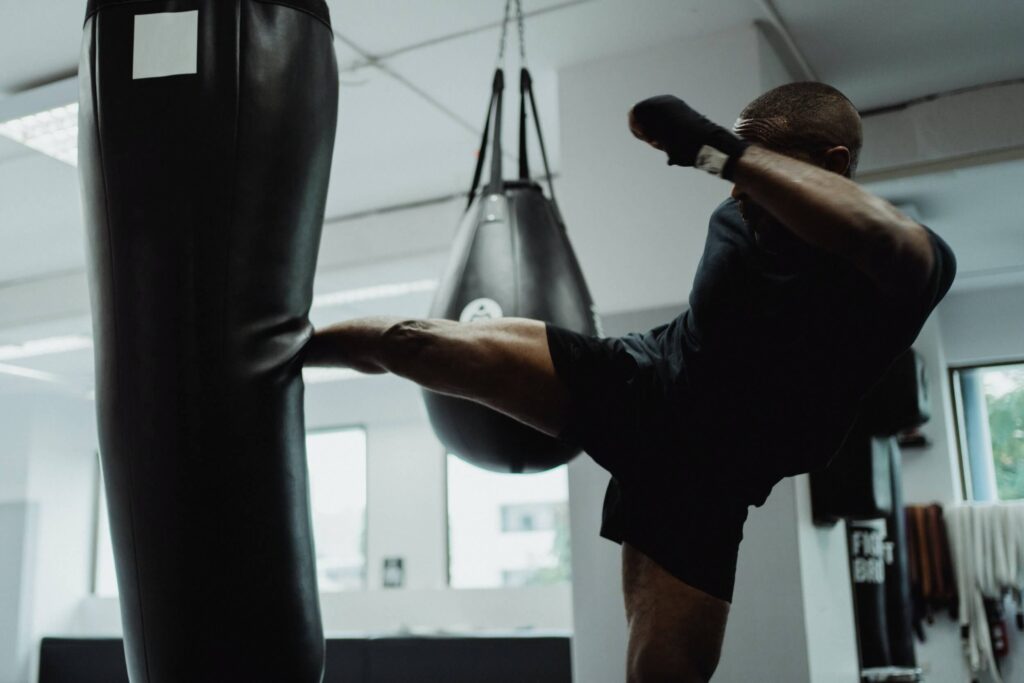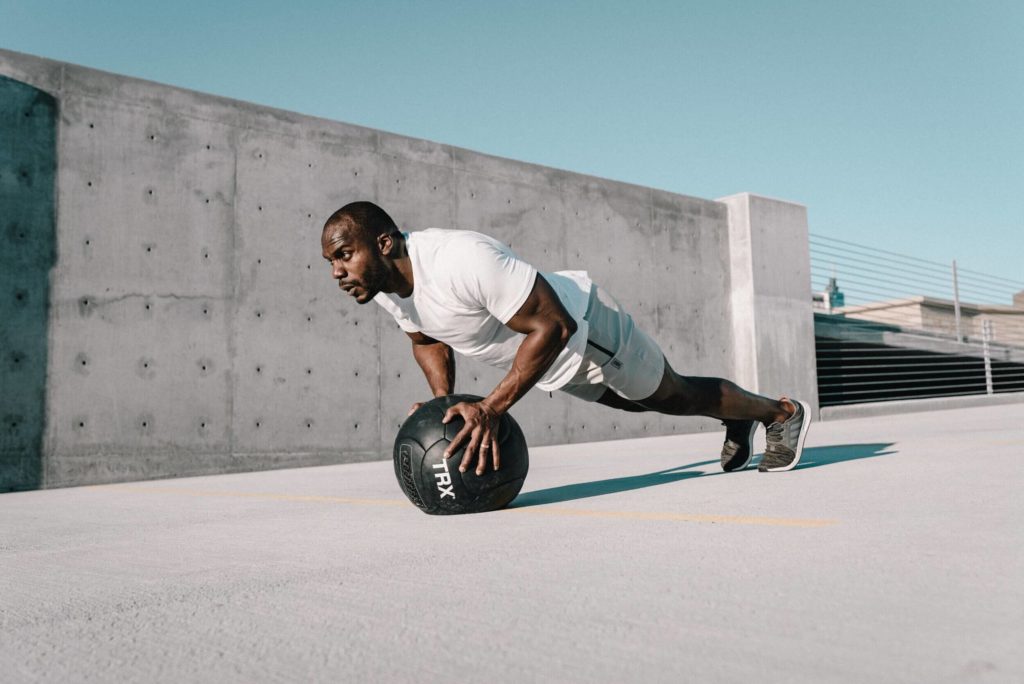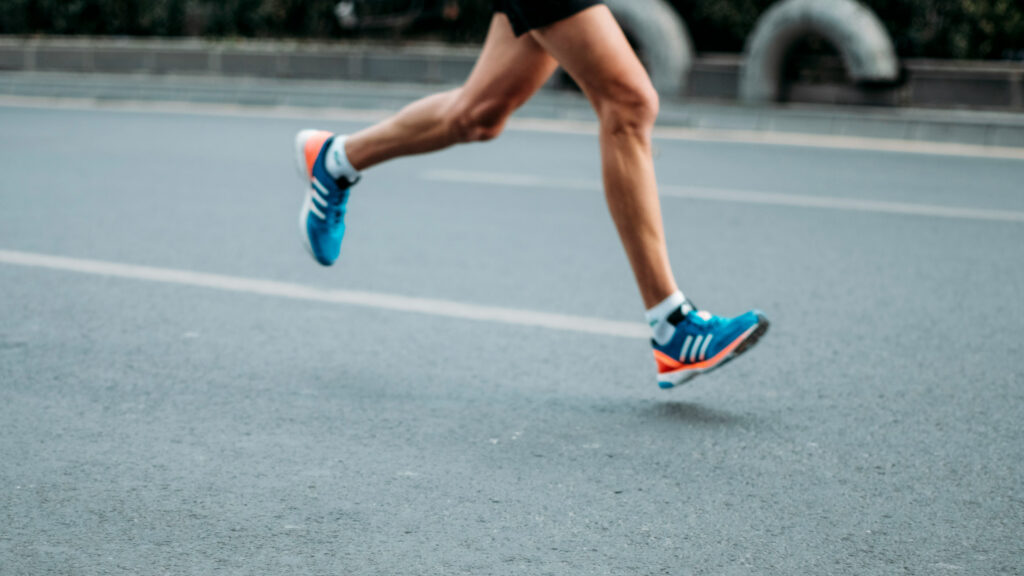Are you tired of running on the treadmill or simply lifting weights? Is your fitness regimen becoming stale and mundane? In order to stay healthy, the US Department of Health and Human Services recommends that adults get between 150 and 300 minutes of moderately intense or between 75 and 150 minutes of vigorously intense physical aerobic activity per week. If you’re looking for a new way to break a sweat and reach these targets, we’ve got you covered. Kick the monotony out of your current fitness programme and consider kickboxing—a sure-fire way to get a comprehensive workout, keep you on your toes and make you feel great.

Highlights
- Kickboxing is a form of martial art – a kind of high-intensity combat sport that involves punching, kicking, and footwork,
- Since it uses both aerobic and anaerobic energy systems, it can improve insulin sensitivity,
- A full-body workout, kickboxing can improve our heart health, reflexes, posture and carries many psychological benefits like stress reduction and anger management.
What is kickboxing?
Kickboxing is a high-intensity modern combat sport. Competitively, it generally involves two opponents directing full-force strikes at each other with their bare hands, elbows, knees, shins and feet. There are many styles of kickboxing that have developed across the globe, each with its own subtle variations, including the American and European styles, the French savate, the Chinese sanda/sanshou and the eponymous Muay Thai. Typically, athletes compete in several rounds that last between 2–4 minutes each, separated by a rest period of 1–2 minutes. Recently, non-contact forms such as cardio or aerobic kickboxing have gained popularity as a legitimate exercise routine. In this instructor-led class, members either spar with a partner, direct their punches and kick into the air or at a punching bag or pads.
Classes last anywhere between 30 and 60 minutes. They commence with a light cardiovascular warm-up that includes static stretches and more complex exercises such as jumping jacks, push-ups and burpees to elevate the heart rate. This is followed by the aerobic portion of the class, where participants execute a dynamic combination of punches and kicks. Sweeping punches such as crosses, hooks and uppercuts are combined with jabs, knee strikes, squats and lunges, all synchronized with nimble footwork. The repetitive nature of the hand and leg movements reinforce the proper technique and concentrate effort on several muscle groups. Finally, members cool down with floor exercises and stretches. Kickboxing mixes martial arts with intense cardio, taxing both our aerobic and anaerobic systems.
Aerobic exercise is any activity that incorporates large muscle groups (such as our arms, legs and hips), can be sustained for a period of time and is rhythmic in nature. The aerobic system contributes to the ability to repeat attacks at the same strength and speed level during combat, in order to optimise recovery in between periods of rest or reduced effort and for effective recovery in between consecutive combats. Anaerobic exercise refers to any activity that breaks down glucose for energy without employing oxygen. In the context of kickboxing, the anaerobic-metabolism pathway provides energy for short and intense attacks of maximum power during combat. Read more about the difference between aerobic and anaerobic metabolism here.
Why you should sign up for kickboxing
In addition to its aerobic and anaerobic activity advantages, kickboxing induces numerous physical, physiological and psychological benefits.
It improves cardiovascular health
Kickboxing is essentially an interval-based workout or a form of high-intensity interval training (HIIT). HIIT alternates short bursts of intense activity (anaerobic) with longer intervals of less-intense activity. Over time, HIIT improves one’s aerobic capacity, meaning you can exercise longer and with greater intensity (thereby increasing stamina). An indicator of cardiovascular endurance is VO2 max, which measures the maximum amount of oxygen expended during physical activity. The higher your VO2 max, the more efficiently your body uses oxygen while you exercise.
A study examined the effects of kickboxing versus conventional exercise over a period of 5 weeks among a group of 30 participants. By the end of the study, the kickboxing group had significantly improved levels of VO2 max and maximal aerobic power as compared to the control group, which showed little to no improvement in both parameters.
Improved aerobic capacity boosts high-density lipoprotein (HDL or good cholesterol) and lowers low-density lipoprotein (LDL or bad cholesterol), which results in less plaque build-up in our arteries. It lowers our blood pressure and controls blood sugar, thus reducing the risk of cardiovascular disease and type 2 diabetes.
It’s a full-body workout
Whether you’re sparring with a partner or laying into a punching bag, kickboxing ensures you get a full-body workout. Rather than targeting a specific muscle, the dynamic combination drills target numerous muscle groups all at once. Major muscle groups that become strengthened include the core, shoulders, arms, back, glutes and legs.
Due to the explosive nature of kickboxing and the rotation required to carry out the kicks and punches, you are constantly engaging your core to stay balanced. If you suffer from poor posture, kickboxing will attend to the neglected muscles in your abdomen. The power required for kicking and punching is generated by the entire body, beginning with the lower body and up through the core. Perfecting the proper form and technique is therefore crucial to strengthening and toning your muscles.
In the same five-week study discussed above, participants were put through several tests of upper-body and lower-body strength before and after the period. The kickboxing group exhibited greater improvement in anaerobic fitness, flexibility, speed and agility.
It improves coordination and reflexes
Kickboxing ‘constantly requires you to think, change your position, and change your posture’, according to physical therapist Linda Arslanian, director of rehabilitation services at the Harvard-affiliated Brigham and Women’s hospital in Boston. While engaged in combat, individuals usually have little reaction time to respond quickly to stimuli and have to wholly concentrate on landing their own combinations. Moreover, kicking involves balancing on one leg and can improve reactive and anticipatory balance. This is especially important for seniors who will be able to better protect themselves from inadvertent falls. Kickboxing sharpens one’s reflexes and improves hand-eye coordination, balance and mobility.
It lowers blood glucose
According to experts since kickboxing is a combination of aerobic and resistance training, it holds possibilities to improve the action of insulin and increases insulin sensitivity.
It has multiple psychological benefits
Kickboxing, amid other forms of martial arts, has been linked to enhanced mental health and positive feelings. Research also shows that kickboxing can cause modifications in the part of the brain that can improve anxiety, stress and depression. Stress results in the accumulation of muscle tension; punching helps to relieve this tension and alleviate stress. It also increases the stimulation of the feel-good neurotransmitters—endorphins. According to boxing coach Tanya Morgan, boxing enables the safe release of aggression and anger.
It can aid in weight loss
Kickboxing is a high-power cardio routine that burns more calories during moments of intense activity. The American Council for Exercise in San Diego estimates that a person weighing 135 lbs (around 60 kilograms) can burn up to 350–450 calories during a 50-minute kickboxing session. Research also reveals that kickboxers exhibit more muscle mass and lower percentages of body fat.

What beginners should know
- If you are new to kickboxing, here are a few dos and don’ts to help you ease into the sport.
- DO wear loose clothing (to facilitate movement) and athletic shoes. Some classes give you the option to train barefoot.
- DO begin slowly. Start at your own pace to reduce the risk of injury. Whole-body movements involved in kickboxing can cause a variety of injuries. Common injuries to kickboxers occur to the head (concussion), shoulders, arms, lower back, hips, knees and thighs.
- DON’T lock your joints while kicking or punching. Form is everything.
- DON’T use weights (wearable or dumbbells) while throwing punches or kicks. This puts extra pressure on the joints.
- DON’T overextend kicks. Get accustomed to the routine and work your way up to higher levels of flexibility.
- DON’T give in to peer pressure and overtrain. Learn more about the pitfalls of overtraining here.
Before beginning your kickboxing journey, you should speak with an instructor about your goals—go over what you’d like to achieve from the kickboxing lessons. Depending on the type of class, they might recommend you purchase gear such as gloves, a mouthguard and ankle tape. In the event of any pre-existing medical condition, speak to your doctor before signing up.
Conclusion
Kickboxing is a high-impact, high-intensity combat sport. It has developed into a group-class format that is a legitimate way to achieve a full-body workout. Kickboxing is essentially a form of interval training—mixing cardio and martial arts. The kicking and punching movements along with heavy core involvement improve one’s aerobic capacity. Over time, the individuals benefit from an increase in endurance, speed, strength and power.
Apart from activating the aerobic and anaerobic pathways, kickboxing has numerous health benefits too. It is seen that cardiorespiratory health is vastly improved, reducing blood pressure and the risk of cardiovascular disease. Kickboxing also releases endorphins into your bloodstream which boosts mood and self-esteem. Coordinated movements and constant attention to form improve overall flexibility and balance. Besides engaging the core, large muscle groups such as the arms, legs and hips are strengthened and toned through kickboxing.
One can reap the true benefits of kickboxing only if one continues to perfect the technique. It is thus recommended to begin slowly with a group class, and speak to your instructor to identify your goals, be it weight loss or strengthening. Kick on!
Disclaimer: The contents of this article are for general information and educational purposes only. It neither provides any medical advice nor intends to substitute professional medical opinion on the treatment, diagnosis, prevention or alleviation of any disease, disorder or disability. Always consult with your doctor or qualified healthcare professional about your health condition and/or concerns and before undertaking a new healthcare regimen including making any dietary or lifestyle changes.
References
- https://health.gov/sites/default/files/2019-10/PAG_ExecutiveSummary.pdf
- https://www.ncbi.nlm.nih.gov/pmc/articles/PMC5424459/
- https://www.health.harvard.edu/exercise-and-fitness/punch-up-your-exercise-routine-with-fitness-boxing
- https://www.healthline.com/health/fitness-exercise/cardio-kickboxing
- https://www.ncbi.nlm.nih.gov/pmc/articles/PMC5329739/







